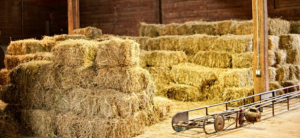 As grass begins to “green up,” horses wander further away from their hay piles and nip at succulent new grass. What are you going to do with the leftover hay in your loft?
As grass begins to “green up,” horses wander further away from their hay piles and nip at succulent new grass. What are you going to do with the leftover hay in your loft?
“Hay doesn’t spoil or go rancid like some other old feeds,” said Catherine Whitehouse, M.S., a nutritionist with Kentucky Equine Research (KER). “If kept in a dry place, hay can last for quite a while, sometimes up to two years.”
Having baled hay on hand is wise, as there always seems to be a need for it, whether it’s used to fill haynets for traveling, tending to a stalled horse, or providing forage for a drylot-kept fatty.
But when is hay too old to use?
“Evaluate the hay critically. Smell it, shake it, inspect it. Any hay that is dusty, moldy, or otherwise unsuitable should be thrown out,” advised Whitehouse. “In loft situations, especially in little-used barns, wildlife sometimes run amok. If hay has been contaminated with urine and feces from raccoons, opossums, or other pests, it too should be discarded, as some of these animals shed disease-causing organisms.”
If you’re unsure whether to feed hay because of age or contamination, it’s best not to.
In need of feeding advice? J & J Hay Farms can help you! We sell only first quality hay period. You can see it, smell it and touch it in every bale we sell. We care about your horse’s health!
Article source: KER.
